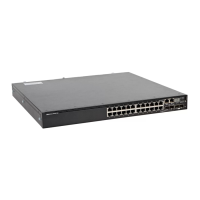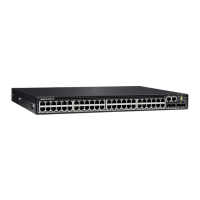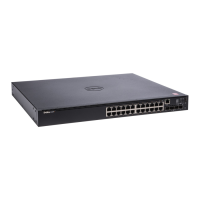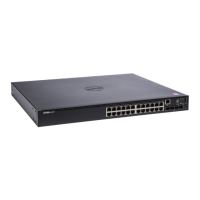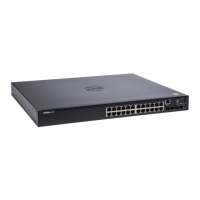Configuring IPv6 Routing 1263
IPv6 Static Reject and Discard Routes
A static configured route with a next-hop of “null” causes any packet
matching the route to disappear or vanish from the network. This type of
route is called a “Discard” route if the router returns an ICMP “network-
unreachable” message, or is called a “Reject” route if no ICMP message is
returned. The Dell Networking series switches support “Reject” routes, where
any packets matching the route network prefix silently disappear.
A common use of a Reject route is to quickly discard packets that cannot be
delivered because a valid route to the destination is not known. Without the
Reject route, these undeliverable packets will continue to circulate through
the network, following the default routes, until their TTL expires. Forwarding
packets that cannot be delivered wastes bandwidth, particularly on expensive
WAN connections. The Reject route will also suppress a type of “Denial of
Service” (DoS) attack where an internal host sends large numbers of packets
to unknown destinations, causing congestion of the WAN links.
• ipv6 route ::/0 null 254
Use this in all routers except the ones with direct Internet connectivity.
Routers with direct Internet connectivity should advertise a default route.
The effect of this route is that when a router does not have connectivity to
the Internet, the router will quickly discard packets that it cannot deliver.
If the router learns a default route from another router, the learned route
will have a lower distance metric and therefore a higher preference. Routes
that are more specific (have more bits in the prefix) will have precedence
over less specific routes. This will cause packets destined for non-existent
networks to be quickly discarded. Also, because of the high distance metric
(254), this route will never be advertised to any neighbor routers.
• ipv6 route fc00::/7 null 254
This route covers the entire ULA (IPv6 private) address space. If you have
networks configured in this address space, you will have more specific
routes for those networks. The more specific routes (more bits of prefix)
will have precedence over this route. Any destinations in this range not
known via another, more specific route do not exist. The effect is that
packets destined for private networks that do not exist in your network will
be quickly discarded instead of being forwarded to the default route.

